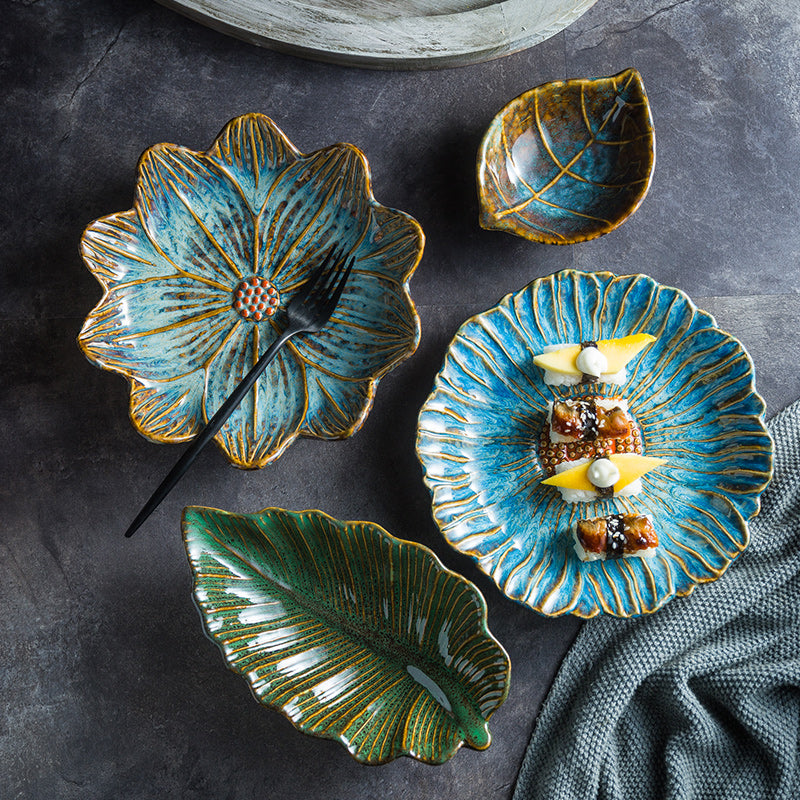Article: Guide to understanding the differences between: Ceramic, Porcelain, Stoneware and more

Guide to understanding the differences between: Ceramic, Porcelain, Stoneware and more
What are the differences between porcelain, ceramic, stoneware, earthenware and slip?
Have you ever wondered, as you gaze at shelves filled with beautiful dinnerware, "What's the secret to choosing the perfect dinnerware for every moment?" Whether you're setting the table for a formal dinner party or a casual brunch, choosing your dinnerware can transform the experience. In this article, we guide you through the intricacies of different dinnerware materials— ceramic, porcelain, stoneware , and more—to help you choose based on your needs and special occasions. Get ready to become a dinnerware expert, able to distinguish a stoneware bowl from a porcelain plate with ease!

Porcelain or Ceramic: What's the Difference?
Porcelain and ceramic are often discussed in the world of tableware, but do you really know what sets them apart? Porcelain, often considered the finest material, is renowned for its finesse, translucency, and surprising strength despite its delicate appearance. Perfect for special occasions, porcelain adds a touch of elegance and sophistication to your table. Imagine serving a festive dinner on shimmering porcelain plates —it's guaranteed to be a memorable evening!
Ceramic , on the other hand, is an umbrella term that encompasses a variety of materials, including porcelain. More robust and versatile, ceramic is ideal for everyday use. With its wide range of finishes, from rustic to contemporary, it adapts to any kitchen style. Whether for a quiet morning coffee or a lively family dinner, opting for ceramic plates means choosing durability without sacrificing aesthetics.

So, how do you choose between porcelain and ceramic? Consider the occasion and your lifestyle. If you enjoy elegant and formal dining, porcelain is your ally. For everyday and versatile use, turn to ceramic . No matter your choice, each material brings its own unique charm to your dining experience.
Sandstone: The Choice of Durability and Natural Style
Stoneware is the unsung hero of the tableware world. It's a fantastic choice for those looking to combine durability with natural style. Known for its strength and impact resistance, stoneware is ideal for everyday use. Its earthy textures and colors add a warm, natural touch to your table, making it an excellent choice for family meals or informal dinner parties.

Incorporating stoneware into different dining settings is a breeze. For a Sunday brunch, for example, stoneware plates in soft colors create a relaxing atmosphere. For an outdoor barbecue, opt for sturdy stoneware bowls —they're virtually unbreakable and add a rustic touch to your outdoor table.
Earthenware: Why Choose Color and Tradition?
Earthenware is a splendid choice for those who love color and tradition in their tableware. With its colorful glazes and glossy appearance, earthenware brings joy to every meal. Although less robust than porcelain or stoneware, it shines with its artistic appearance and often colorful and elaborate patterns.

Using earthenware in the right settings can really bring out its charm. It's perfect for special occasions like afternoon tea or festive meals. Imagine a table set with earthenware plates adorned with floral motifs for a spring lunch—it promises a joyful and memorable experience.
The Art of Slush in Modern Tableware
Slip casting brings a unique artistic dimension to modern tableware. This technique creates raised designs on ceramic, giving each piece a unique character and tangible texture. Slip casting is perfect for those looking to add a touch of originality to their table.

Incorporating slip pieces into your tablescape can transform an ordinary meal into an artistic experience. For example, use a slip vase as a centerpiece at a dinner party or slip dishes to serve hors d'oeuvres at a reception. Each piece will attract attention and spark conversation, making your time around the table even more special.
Comparing Materials: Advantages and Disadvantages
When choosing your tableware, each material offers advantages and disadvantages. Here's a comparison chart to help you navigate your options:
| Material | Benefits | Disadvantages |
|---|---|---|
| Porcelain | Finesse, elegance, resistance to shocks and heat. | More expensive, can be fragile. |
| Ceramic | Wide variety of styles, durable, ideal for everyday use. | May be heavier than porcelain, less refined. |
| Sandstone | Very durable, ideal for frequent use, natural appearance. | Less formal, variations in color and texture. |
| Earthenware | Colorful, artistic patterns, shine. | Less resistant, can chip easily. |
| Slip | Unique, creative, embossed appearance. | More fragile, requires special care. |
Guide to selecting the right material for each need:
- Porcelain : Perfect for special occasions, elegant receptions.
- Ceramic : Ideal for everyday use, easy to match with different decoration styles.
- Stoneware : Excellent for family meals, brunches, or a rustic style.
- Earthenware : Suitable for afternoon teas, cheerful events, colorful decoration.
- Barbotine : Ideal for collectors or to add an artistic accent to your table.

Expert Tips for Combining Style and Functionality
- Mix and match : Don't be afraid to combine different materials. For example, porcelain plates for the main course and ceramic cups for coffee can create an interesting contrast.
- Play with textures : Pair smooth pieces like porcelain with more textured elements like stoneware or slip to add depth to your table.
- Color and Pattern : Use earthenware pieces to add vibrant pops of color to an otherwise neutral table.
- Functionality first : Choose materials that fit your lifestyle. If you have an active family or use your dishes frequently, opt for sturdier materials like stoneware or ceramic.
By keeping these tips in mind, you can choose tableware pieces that combine beauty and practicality, creating tables that are both functional and aesthetically pleasing.
How to recognize them?
Here are some techniques for recognizing different tableware materials:
-
Porcelain :
- Texture : Smooth and fine to the touch.
- Appearance : Translucent, often with a glossy sheen.
- Sound : Emits a clear, high-pitched sound when tapped.
- Weight : Generally lighter than other ceramics.
-
Ceramics :
- Texture : Thicker and less delicate than porcelain.
- Appearance : Can vary greatly, usually opaque.
- Sound : Less distinct and more muffled sound than porcelain.
- Weight : Heavier and more robust.
-
Sandstone :
- Texture : Often textured, with a natural, raw appearance.
- Appearance : Earthy colors and matte finishes common.
- Sound : Produces a dull, solid sound.
- Weight : Quite heavy and dense.
-
Earthenware :
- Texture : Smooth surface but may be slightly more porous than porcelain.
- Appearance : Characterized by bright colors and decorative patterns.
- Sound : Duller sound than porcelain, but similar.
- Weight : Lighter than stoneware, but heavier than porcelain.
-
Slip :
- Texture : Noticeable relief due to the appliqué decorations.
- Appearance : 3D designs, often with elaborate details.
- Sound : Varies depending on the ceramic base used.
- Weight : Varies, but generally similar to standard ceramic.
By examining these characteristics, you can better identify the type of dinnerware you are looking at, whether for a purchase or to evaluate what you already have at home.

Discover the Japan at Home Collection
Japan at Home offers an exquisite range of tableware that blends Japanese tradition with contemporary design. Our collection includes a variety of materials, each carefully selected for its quality and aesthetic appeal. Whether you're looking for elegant porcelain plates for formal dinners, sturdy stoneware bowls for everyday use, or colorful earthenware pieces to brighten up your meals, Japan at Home has something for every occasion.
We understand that every home has its own unique needs and styles. That's why our collection is designed to meet a variety of preferences while ensuring the highest quality. Whether you prefer sleek minimalism or a bolder, more colorful style, our range offers a wide selection to perfectly complement your table and kitchen.
Conclusion: you are now a dishwashing expert!
With the knowledge you've gained about different tableware materials—their textures, benefits, and optimal use occasions—you're now equipped to make informed choices. Whether you're a tableware enthusiast or simply looking for the perfect tableware for your home, these tips will help you make informed decisions.
We invite you to apply these tips as you explore Japan at Home 's diverse collection. Discover how our unique pieces can enrich your dining experience and beautify your table. At Japan at Home, we pride ourselves on helping you become a true tableware expert, while bringing a touch of Japanese refinement to your everyday life.

